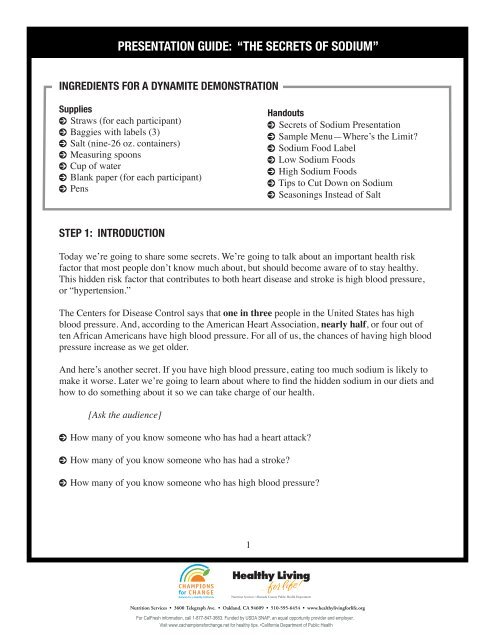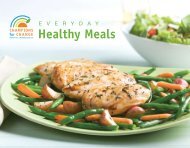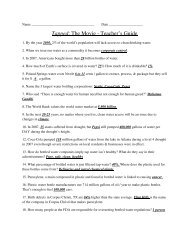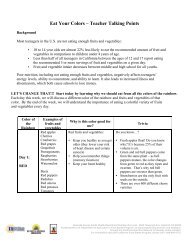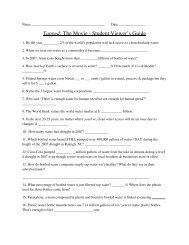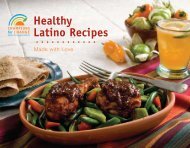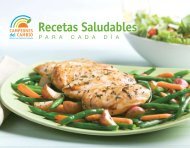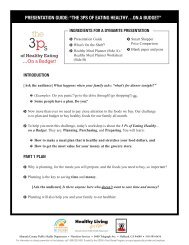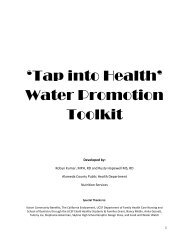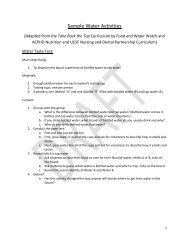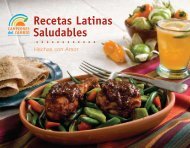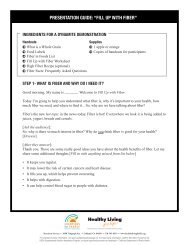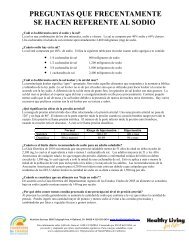presentation guide: âthe secrets of sodiumâ - Healthy Living...for life!
presentation guide: âthe secrets of sodiumâ - Healthy Living...for life!
presentation guide: âthe secrets of sodiumâ - Healthy Living...for life!
You also want an ePaper? Increase the reach of your titles
YUMPU automatically turns print PDFs into web optimized ePapers that Google loves.
PRESENTATION GUIDE: “THE SECRETS OF SODIUM”<br />
INGREDIENTS FOR A DYNAMITE DEMONSTRATION<br />
Supplies<br />
0 Straws (<strong>for</strong> each participant)<br />
0 Baggies with labels (3)<br />
0 Salt (nine-26 oz. containers)<br />
0 Measuring spoons<br />
0 Cup <strong>of</strong> water<br />
0 Blank paper (<strong>for</strong> each participant)<br />
0 Pens<br />
Handouts<br />
0 Secrets <strong>of</strong> Sodium Presentation<br />
0 Sample Menu—Where’s the Limit<br />
0 Sodium Food Label<br />
0 Low Sodium Foods<br />
0 High Sodium Foods<br />
0 Tips to Cut Down on Sodium<br />
0 Seasonings Instead <strong>of</strong> Salt<br />
STEP 1: INTRODUCTION<br />
Today we’re going to share some <strong>secrets</strong>. We’re going to talk about an important health risk<br />
factor that most people don’t know much about, but should become aware <strong>of</strong> to stay healthy.<br />
This hidden risk factor that contributes to both heart disease and stroke is high blood pressure,<br />
or “hypertension.”<br />
The Centers <strong>for</strong> Disease Control says that one in three people in the United States has high<br />
blood pressure. And, according to the American Heart Association, nearly half, or four out <strong>of</strong><br />
ten African Americans have high blood pressure. For all <strong>of</strong> us, the chances <strong>of</strong> having high blood<br />
pressure increase as we get older.<br />
And here’s another secret. If you have high blood pressure, eating too much sodium is likely to<br />
make it worse. Later we’re going to learn about where to find the hidden sodium in our diets and<br />
how to do something about it so we can take charge <strong>of</strong> our health.<br />
[Ask the audience]<br />
0 How many <strong>of</strong> you know someone who has had a heart attack<br />
0 How many <strong>of</strong> you know someone who has had a stroke<br />
0 How many <strong>of</strong> you know someone who has high blood pressure<br />
1<br />
Nutrition Services • 3600 Telegraph Ave. • Oakland, CA 94609 • 510-595-6454 • www.healthyliving<strong>for</strong><strong>life</strong>.org<br />
For CalFresh in<strong>for</strong>mation, call 1-877-847-3663. Funded by USDA SNAP, an equal opportunity provider and employer.<br />
Visit www.cachampions<strong>for</strong>change.net <strong>for</strong> healthy tips. •Cali<strong>for</strong>nia Department <strong>of</strong> Public Health
PRESENTATION GUIDE: “THE SECRETS OF SODIUM”<br />
STEP 2: KNOW YOUR BLOOD PRESSURE<br />
Let’s talk about blood pressure:<br />
• Blood pressure is the <strong>for</strong>ce created by the heart as it pushes blood through the blood<br />
vessels in your body.<br />
• High blood pressure occurs when the <strong>for</strong>ce <strong>of</strong> blood flowing through your vessels is too high<br />
and your heart must work harder. This increased pressure puts extra stress on the blood<br />
vessels themselves and on vital organs such as your heart and kidneys.<br />
• Let me show you what happens to your blood vessels when you do have high blood pressure:<br />
Demonstration <strong>of</strong> High Blood Pressure<br />
Take a straw and blow through it. What happens Air flows freely through the straw.<br />
This is how it feels to have normal blood pressure. Now pinch the straw in the middle<br />
and blow through it. What happens See how much more <strong>for</strong>ce you have to use to get<br />
the air through the straw when it’s blocked<br />
This is the same thing your heart has to do every minute <strong>of</strong> the day just to pump your<br />
blood to your organs and throughout your entire body.<br />
• If you have high blood pressure, this excessive <strong>for</strong>ce is damaging the inside <strong>of</strong> your blood<br />
vessels, and that damage can lead to stroke, heart attack, heart failure, kidney failure,<br />
or blindness.<br />
• Your heart could be working this hard and you don’t even know it. That’s why high blood<br />
pressure is <strong>of</strong>ten called “the silent killer”. It is especially dangerous because there are no<br />
clear signs. A person can have it and not even know it.<br />
Here’s a really important question:<br />
How many <strong>of</strong> you know what your blood pressure is<br />
• Everybody should know their own blood pressure because people with high blood pressure<br />
are more likely to develop heart disease and stroke. These diseases are the No. 1 and No. 3<br />
killers in the United States today.<br />
• Normal blood pressure is at or below 120 over 80 (120/80) <strong>for</strong> adults.<br />
2<br />
Nutrition Services • 3600 Telegraph Ave. • Oakland, CA 94609 • 510-595-6454 • www.healthyliving<strong>for</strong><strong>life</strong>.org<br />
For CalFresh in<strong>for</strong>mation, call 1-877-847-3663. Funded by USDA SNAP, an equal opportunity provider and employer.<br />
Visit www.cachampions<strong>for</strong>change.net <strong>for</strong> healthy tips. •Cali<strong>for</strong>nia Department <strong>of</strong> Public Health
PRESENTATION GUIDE: “THE SECRETS OF SODIUM”<br />
• If your blood pressure is above 120 over 80 you may be at risk <strong>for</strong> high blood pressure, and<br />
the only way to tell if you have high blood pressure is to have your blood pressure checked.<br />
• If you do have high blood pressure, here’s what you need to do:<br />
1. See a doctor.<br />
2. Follow the treatment your doctor prescribes which may include medication, losing weight,<br />
physical activity and healthy eating, including reducing sodium intake. Salt is the biggest<br />
source <strong>of</strong> sodium in your diet.<br />
• Even if you don't have high blood pressure, it is still a good idea to limit your salt intake.<br />
STEP 3: UNDERSTAND THE IMPACT OF SODIUM ON BLOOD PRESSURE<br />
Now we’re going to talk about blood pressure and sodium:<br />
• Experts believe that a diet high in sodium is a major cause <strong>of</strong> high blood pressure. It is also<br />
suggested that people trying to lower their blood pressure should also boost their potassium.<br />
Potassium is a mineral much like sodium. In the body, it works together with sodium to maintain<br />
proper fluid balance.<br />
• The good news is that <strong>for</strong> most people, eating less sodium and eating foods that are rich in<br />
potassium (some fruits, vegetables, fish, and low fat dairy foods) is an important step in lowering<br />
your blood pressure, which in turn will reduce your risk <strong>of</strong> developing heart disease, stroke, and<br />
kidney disease.<br />
How Much Sodium Does the Average American Eat<br />
• Let me show you what the average American’s yearly salt consumption looks like:<br />
[Pull nine 26 oz. salt containers out from under the table and place on the table <strong>for</strong> the<br />
audience to see] This is equal to a gallon and a half <strong>of</strong> salt!<br />
• Experts recommend that a safe daily intake <strong>of</strong> sodium <strong>for</strong> healthy adults is less than 2,300 mg.,<br />
which is about 1 teaspoon <strong>of</strong> salt. And it looks like this. [Show baggie]<br />
• However, <strong>for</strong> adults over age 51, and those <strong>of</strong> any age who are African American or have<br />
hypertension, diabetes or chronic kidney disease, the new 2010 Dietary Guidelines recommend<br />
a sodium intake <strong>of</strong> 1,500 mg., which is about two-thirds (2/3) a teaspoon <strong>of</strong> salt. [Show baggie]<br />
• Now let’s see how quickly we can reach that safe upper limit <strong>of</strong> 2,300 mg. eating some <strong>of</strong><br />
our favorite foods.<br />
3<br />
Nutrition Services • 3600 Telegraph Ave. • Oakland, CA 94609 • 510-595-6454 • www.healthyliving<strong>for</strong><strong>life</strong>.org<br />
For CalFresh in<strong>for</strong>mation, call 1-877-847-3663. Funded by USDA SNAP, an equal opportunity provider and employer.<br />
Visit www.cachampions<strong>for</strong>change.net <strong>for</strong> healthy tips. •Cali<strong>for</strong>nia Department <strong>of</strong> Public Health
PRESENTATION GUIDE: “THE SECRETS OF SODIUM”<br />
STEP 4: DEMONSTRATE—WHERE’S THE SODIUM LIMIT<br />
• [Show Sample Menu handout] On this side <strong>of</strong> the handout, we’ve selected a typical menu<br />
<strong>of</strong> popular foods to show you how easy it is <strong>for</strong> sodium to sneak in to your daily diet. On<br />
the other side <strong>of</strong> the handout, the graphic shows what’s happening to the daily limit <strong>of</strong><br />
sodium as we eat these foods over the course <strong>of</strong> a day.<br />
• Let’s take a look at a typical American breakfast. If you eat bacon, eggs, a bagel and orange<br />
juice, you’ll have close to 1,200 mg. <strong>of</strong> sodium, which is about half a teaspoon <strong>of</strong> salt.<br />
[Ask <strong>for</strong> a volunteer to spoon the salt into a baggie and hold it up <strong>for</strong> the audience to see].<br />
• [Refer to Sample Menu handout] Now let’s see what happens when we add the sodium from<br />
this typical soup and sandwich lunch. All together lunch contains about 2,400 mg. <strong>of</strong> sodium,<br />
which is more than 1 teaspoon <strong>of</strong> salt. [Ask the volunteer to add 1 teaspoon <strong>of</strong> salt into<br />
the baggie from breakfast, and show the baggie]<br />
• On the backside <strong>of</strong> the handout [hold up the “Where’s the Limit” drawing <strong>of</strong> salt shakers]<br />
we can see how we’ve already gone into the Danger Zone, because lunch alone has more<br />
sodium than your entire daily limit!<br />
• So, with breakfast and lunch we’re up to 3,600 mg. <strong>of</strong> sodium. Can anyone tell me what is<br />
the recommended daily limit <strong>of</strong> sodium That’s right—2,300 mg. We’re over the limit and<br />
we haven’t even had dinner yet!<br />
• Let’s see what happens when we add the 3,400 mg. sodium from a fast food dinner, which is<br />
about 1½ teaspoons <strong>of</strong> salt. We now have a grand total <strong>of</strong> 7,000 mg. <strong>of</strong> sodium, or 3 teaspoons<br />
<strong>of</strong> salt, which is more than three times the recommended daily amount <strong>of</strong> sodium! And, close to<br />
five times the recommended daily amount <strong>for</strong> those at risk.<br />
• Here’s what 3 teaspoons looks like [show baggie]. And again, here’s what the recommended<br />
amount looks like [show baggie].<br />
• [Give the baggie with 3 teaspoons <strong>of</strong> salt to the volunteer] Now I’m going to ask our volunteer<br />
to pour the 3 teaspoons <strong>of</strong> salt from our typical menu into this cup <strong>of</strong> water. [Hold up cup <strong>of</strong><br />
salt water] This is the amount <strong>of</strong> salt most <strong>of</strong> us consume in a day!<br />
• [Ask] Who would like to drink this<br />
4<br />
Nutrition Services • 3600 Telegraph Ave. • Oakland, CA 94609 • 510-595-6454 • www.healthyliving<strong>for</strong><strong>life</strong>.org<br />
For CalFresh in<strong>for</strong>mation, call 1-877-847-3663. Funded by USDA SNAP, an equal opportunity provider and employer.<br />
Visit www.cachampions<strong>for</strong>change.net <strong>for</strong> healthy tips. •Cali<strong>for</strong>nia Department <strong>of</strong> Public Health
PRESENTATION GUIDE: “THE SECRETS OF SODIUM”<br />
STEP 5: MAKE HEALTHY CHOICES<br />
You’ve seen how easy it is <strong>for</strong> too much sodium to get into your diet, but where does all this<br />
sodium come from<br />
• It’s surprising, but only a small amount <strong>of</strong> the sodium we eat comes from adding salt at the<br />
table or adding salt when we cook.<br />
• What’s really important to understand is that almost 80 percent <strong>of</strong> the sodium we eat is<br />
“hidden” in prepared or processed foods.<br />
• It gets into our diet from breakfast cereals, cheese, frozen dinners, fast food, smoked meats,<br />
canned vegetables, salad dressing, sauces, condiments and snack foods like crackers and chips.<br />
Reading Food Labels<br />
• The only way to know how much sodium is hidden in these prepared foods is to learn<br />
to read the food label. [Distribute Food Label handout] Here’s an example <strong>of</strong> a food label <strong>for</strong><br />
a product that contains sodium.<br />
• Every packaged food product contains a Nutrition Facts label. Check the label and look <strong>for</strong><br />
the word “Sodium.” Can anyone tell me how much sodium is in this package <strong>of</strong> Cheetos®<br />
• You may also find sodium in the Ingredients list. It comes in many <strong>for</strong>ms in addition to salt.<br />
Take a look at all the sodium ingredients in this package <strong>of</strong> Cheetos®!<br />
• So, if you don’t look at the label, you’ll never know how loaded with sodium many food<br />
products are.<br />
STEP 6: CUT DOWN ON YOUR SODIUM INTAKE<br />
By now, I think everyone is hoping <strong>for</strong> some tips on how we can stay within the recommended<br />
limits <strong>of</strong> 2,300 mg. (or less) <strong>of</strong> sodium per day! Here are five suggestions to help you change the<br />
way you eat:<br />
5<br />
Nutrition Services • 3600 Telegraph Ave. • Oakland, CA 94609 • 510-595-6454 • www.healthyliving<strong>for</strong><strong>life</strong>.org<br />
For CalFresh in<strong>for</strong>mation, call 1-877-847-3663. Funded by USDA SNAP, an equal opportunity provider and employer.<br />
Visit www.cachampions<strong>for</strong>change.net <strong>for</strong> healthy tips. •Cali<strong>for</strong>nia Department <strong>of</strong> Public Health
PRESENTATION GUIDE: “THE SECRETS OF SODIUM”<br />
1. Choose fresh foods and eat more fruits and vegetables—they are extremely low in sodium and<br />
a source <strong>of</strong> potassium.<br />
2. Downsize your portions. In general the more calories a meal has, the more sodium it has.<br />
3. Become aware <strong>of</strong> high sodium foods and try to avoid them (and to give you a hint we’ve<br />
provided you with a list <strong>of</strong> high sodium foods).<br />
4. Prepare your own foods so you can control the amount <strong>of</strong> sodium. Use herbs, spices and citrus<br />
instead <strong>of</strong> salt in cooking and at the table [Show Seasonings Instead <strong>of</strong> Salt Handout]<br />
5. If you must eat prepared foods, learn to read labels so you can choose low sodium alternatives.<br />
INTERACTIVE EXERCISE— MAKING HEALTHIER CHOICES<br />
Let’s see if we can practice making healthier choices:<br />
Take a blank piece <strong>of</strong> paper and write down the items you ate in one meal yesterday. Using<br />
your Tips <strong>for</strong> Cutting Down on Sodium and your Low Sodium Foods list, write down one or two<br />
changes you would make in the meal from yesterday to reduce your sodium intake. Then share<br />
your ideas with a partner and hear about the changes they would make.<br />
[Ask] Would anyone like to tell us about the changes they would make in their meal<br />
STEP 7: SHARE WHAT YOU KNOW<br />
We know it’s challenging to make significant changes in the way you eat. Perhaps the most<br />
important tip <strong>of</strong> all is to start small and gradually work up to bigger changes. We’ve given<br />
you tools to show you where to find the sodium in your diet and suggested how to reduce your<br />
sodium so you can lower your risk <strong>of</strong> high blood pressure and heart disease, stroke and kidney<br />
disease. We hope these tools will help you get started with your healthier <strong>life</strong>style.<br />
The <strong>secrets</strong> <strong>of</strong> sodium are out. Now it’s up to you to share the <strong>secrets</strong> with others. Don’t keep<br />
them to yourself!<br />
6<br />
Nutrition Services • 3600 Telegraph Ave. • Oakland, CA 94609 • 510-595-6454 • www.healthyliving<strong>for</strong><strong>life</strong>.org<br />
For CalFresh in<strong>for</strong>mation, call 1-877-847-3663. Funded by USDA SNAP, an equal opportunity provider and employer.<br />
Visit www.cachampions<strong>for</strong>change.net <strong>for</strong> healthy tips. •Cali<strong>for</strong>nia Department <strong>of</strong> Public Health<br />
Revised 4/11


